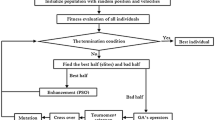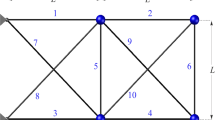Abstract
This paper focuses on the geological adaptive control of tunneling boring machine (TBM). To deal with the issue that the geological condition is uncertain, clustering analysis is used to identify geological types based on two important indices indicating the strength of rock. Based on the results from above, the principles of variation and range of tunneling parameters under different rock condition are determined. Furthermore, considering several vital performances of TBM during tunneling operation, a multi-objective optimization problem is proposed. In the light of non-dominated sorting and crowded distance evaluation concepts in non-dominated sorting genetic algorithm-II, the proposed multi-objective optimization problem is solved by using differential evolution algorithm. Based on the practical construction data, the simulation results show that the proposed method is effective in improving the performance of tunneling operation of TBM, compared with unoptimized operating actions from current systems.






















Similar content being viewed by others
Explore related subjects
Discover the latest articles, news and stories from top researchers in related subjects.References
Ayala HVH, Keller P, de Fátima Morais M, Mariani VC, dos Santos Coelho L, Rao RV (2016) Design of heat exchangers using a novel multiobjective free search differential evolution paradigm. Appl Therm Eng 94:170–177
Baatar N, Jeong KY, Koh CS (2014) Adaptive parameter controlling non-dominated ranking differential evolution for multi-objective optimization of electromagnetic problems. IEEE Trans Magn 50(2):709–712
Baraldi P, Bonfanti G, Zio E (2018) Differential evolution-based multi-objective optimization for the definition of a health indicator for fault diagnostics and prognostics. Mech Syst Signal Process 102:382–400
Bäppler K (2016) New developments in TBM tunnelling for changing grounds. Tunn Undergr Space Technol 57:18–26
Cao L, Xu L, Goodman ED, Li H (2019) Decomposition-based evolutionary dynamic multiobjective optimization using a difference model. Appl Soft Comput 76:473–490
Celebi ME, Kingravi HA, Vela PA (2013) A comparative study of efficient initialization methods for the k-means clustering algorithm. Expert Syst Appl 40(1):200–210
Charles A, Parks G (2019) Application of Differential Evolution algorithms to multi-objective optimization problems in mixed-oxide fuel assembly design. Ann Nucl Energy 127:165–177
Chen X, Du W, Qian F (2014) Multi-objective differential evolution with ranking-based mutation operator and its application in chemical process optimization. Chemom Intell Lab Syst 136:85–96
Deb K (2001) Multi-objective optimization using evolutionary algorithms 16. Wiley, New York
Deb K, Pratap A, Agarwal S, Meyarivan TAMT (2002) A fast and elitist multiobjective genetic algorithm: NSGA-II. IEEE Trans Evol Comput 6(2):182–197
Dudt JP, Delisio A (2016) The “penalty factors” method for the prediction of TBM performances in changing grounds. Tunn Undergr Space Technol 57:195–200
Eftekharian SE, Shojafar M, Shamshirband S (2017) 2-phase NSGA II: an optimized reward and risk measurements algorithm in portfolio optimization. Algorithms 10(4):130
Emmerich MT, Deutz AH (2018) A tutorial on multiobjective optimization: fundamentals and evolutionary methods. Nat Comput 17(3):585–609
Erisoglu M, Calis N, Sakallioglu S (2011) A new algorithm for initial cluster centers in k-means algorithm. Pattern Recogn Lett 32(14):1701–1705
Fabregas AC, Gerardo BD, Tanguilig BT III (2017) Enhanced initial centroids for k-means algorithm. Int J Inf Technol Comput Sci 1:26–33
Festa D, Broere W, Bosch JW (2012) An investigation into the forces acting on a TBM during driving—mining the TBM logged data. Tunn Undergr Space Technol 32:143–157
Ganesan T, Elamvazuthi I, Shaari KZK, Vasant P (2014) Hopfield differential evolution for multi-objective optimization of a cement-bonded sand mould system. Int J Manag Sci Eng Manag 9(1):40–47
Gong Q, Yin L, Ma H, Zhao J (2016) TBM tunnelling under adverse geological conditions: an overview. Tunn Undergr Space Technol 57:4–17
Got A, Moussaoui A, Zouache D (2020) A guided population archive whale optimization algorithm for solving multiobjective optimization problems. Expert Syst Appl 141:112972
Han J, Pei J, Kamber M (2011) Data mining: concepts and techniques. Elsevier, Amsterdam
Home L (2016) Hard rock TBM tunneling in challenging ground: developments and lessons learned from the field. Tunn Undergr Space Technol 57:27–32
Kamjoo A, Maheri A, Dizqah AM, Putrus GA (2016) Multi-objective design under uncertainties of hybrid renewable energy system using NSGA-II and chance constrained programming. Int J Electr Power Energy Syst 74:187–194
Lacerda AS, Batista LS (2019) KDT-MOEA: a multiobjective optimization framework based on KD trees. Inf Sci 503:200–218
Li G, Yu T, Fei X, Wang WS (2012) A method to predict cutterhead specific energy for TBM based on CSM model. J Northeastern Univ (Nat Sci) 33(1):1766–1769
Li X, Yu H, Yuan M, Zhao Y (2013) Research on dynamic models and performances of shield tunnel boring machine cutterhead driving system. Adv Mech Eng 5:359757
Li XH, Yu HB, Yuan MZ, Yin Y, Pan H (2011) Study on the linear dynamic model of shield TBM cutterhead driving system. In: IECON 2011-37th annual conference of the IEEE industrial electronics society, Nov 2011. IEEE, pp 3864–3871
Liang J, Xu W, Yue C, Yu K, Song H, Crisalle OD, Qu B (2019) Multimodal multiobjective optimization with differential evolution. Swarm Evolut Comput 44:1028–1059
Liu Q, Huang X, Gong Q, Du L, Pan Y, Liu J (2016a) Application and development of hard rock TBM and its prospect in China. Tunn Undergr Space Technol 57:33–46
Liu T, Jiao L, Ma W, Ma J, Shang R (2016b) A new quantum-behaved particle swarm optimization based on cultural evolution mechanism for multiobjective problems. Knowl-Based Syst 101:90–99
Madhulatha TS (2012) An overview on clustering methods. arXiv preprint arXiv:1205.1117
Meilă M (2006) The uniqueness of a good optimum for k-means. In: Proceedings of the 23rd international conference on machine learning, June 2006. pp 625–632
Mirjalili S, Saremi S, Mirjalili SM, Coelho LDS (2016) Multi-objective grey wolf optimizer: a novel algorithm for multi-criterion optimization. Expert Syst Appl 47:106–119
Neri F, Tirronen V (2010) Recent advances in differential evolution: a survey and experimental analysis. Artif Intell Rev 33(1–2):61–106
Neto JXV, Junior EJG, Moreno SR, Ayala HVH, Mariani VC, dos Santos Coelho L (2018) Wind turbine blade geometry design based on multi-objective optimization using metaheuristics. Energy 162:645–658
Pooranian Z, Nikmehr N, Najafi-Ravadanegh S, Mahdin H, Abawajy J (2016) Economical and environmental operation of smart networked microgrids under uncertainties using NSGA-II. In: 2016 24th international conference on software, telecommunications and computer networks (SoftCOM), IEEE, Sept 2016, pp 1–6
Price KV (2013) Differential evolution. In: Handbook of optimization. Springer, Berlin, pp 187–214
Qu BY, Liang JJ, Zhu YS, Suganthan PN (2019) Solving dynamic economic emission dispatch problem considering wind power by multi-objective differential evolution with ensemble of selection method. Nat Comput 18(4):695–703
Rabbani M, Heidari R, Yazdanparast R (2019) A stochastic multi-period industrial hazardous waste location-routing problem: Integrating NSGA-II and Monte Carlo simulation. Eur J Oper Res 272(3):945–961
Roselyn JP, Devaraj D, Dash SS (2014) Multi Objective differential evolution approach for voltage stability constrained reactive power planning problem. Int J Electr Power Energy Syst 59:155–165
Rostami J (2016) Performance prediction of hard rock Tunnel Boring Machines (TBMs) in difficult ground. Tunn Undergr Space Technol 57:173–182
Tan KC, Chiam SC, Mamun AA, Goh CK (2009) Balancing exploration and exploitation with adaptive variation for evolutionary multi-objective optimization. Eur J Oper Res 197(2):701–713
Wang C, Fang Y, Guo S (2015) Multi-objective optimization of a parallel ankle rehabilitation robot using modified differential evolution algorithm. Chin J Mech Eng 28(4):702–715
Wang B, Liang Y, Zheng T, Yuan M, Zhang H (2018) Multi-objective site selection optimization of the gas-gathering station using NSGA-II. Process Saf Environ Prot 119:350–359
Wang Q, Wang L, Huang W, Wang Z, Liu S, Savić DA (2019) Parameterization of NSGA-II for the optimal design of water distribution systems. Water 11(5):971
Wang L, Wang T, Wu J, Chen G (2017) Multi-objective differential evolution optimization based on uniform decomposition for wind turbine blade design. Energy 120:346–361
Wang L, Yang Y, Dong C, Morosuk T, Tsatsaronis G (2014) Multi-objective optimization of coal-fired power plants using differential evolution. Appl Energy 115:254–264
Wang S, Zhao D, Yuan J, Li H, Gao Y (2019) Application of NSGA-II algorithm for fault diagnosis in power system. Electr Power Syst Res 175:105893
Yang H, Wang H, Zhou X (2016) Analysis on the damage behavior of mixed ground during TBM cutting process. Tunn Undergr Space Technol 57:55–65
Zhang Z (2019) Fast multiobjective immune optimization approach solving multiobjective interval number programming. Swarm Evolut Comput 51:100578
Zhang J, Xing L, Peng G, Yao F, Chen C (2019) A large-scale multiobjective satellite data transmission scheduling algorithm based on SVM+ NSGA-II. Swarm Evolut Comput 50:100560
Zheng YL, Zhang QB, Zhao J (2016) Challenges and opportunities of using tunnel boring machines in mining. Tunn Undergr Space Technol 57:287–299
Acknowledgements
This work is supported by National Natural Science Foundation of China (No.61533013, 61633019), Key Projects from Ministry of Science and Technology (Nos. 2017ZX07207003, 2017ZX07207005), Shanxi Provincial Key Project (2018ZDXMGY-168) and Shanghai Project (17DZ1202704), MIIT Intelligent Manufacturing Special Project List of Y2017 (No. 54).
Author information
Authors and Affiliations
Corresponding author
Ethics declarations
Conflict of interest
The authors declare no potential conflict of interests.
Additional information
Communicated by V. Loia.
Publisher's Note
Springer Nature remains neutral with regard to jurisdictional claims in published maps and institutional affiliations.
Rights and permissions
About this article
Cite this article
Wang, H., Wang, J., Zhao, Y. et al. Tunneling parameters optimization based on multi-objective differential evolution algorithm. Soft Comput 25, 3637–3656 (2021). https://doi.org/10.1007/s00500-020-05392-8
Published:
Issue Date:
DOI: https://doi.org/10.1007/s00500-020-05392-8




